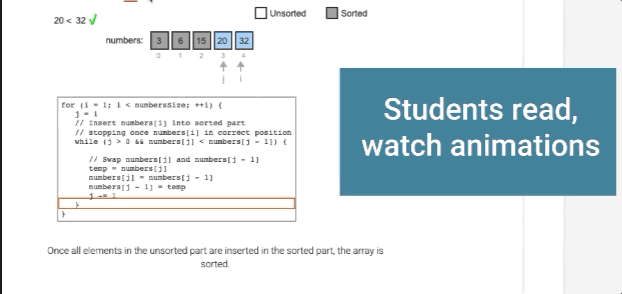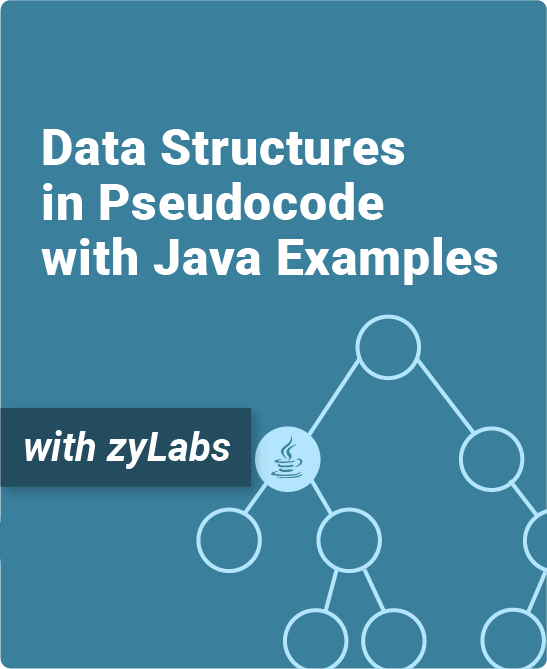Table of Contents
1. Introduction to Data Structures and Algorithms
1.1 Data Structures
1.2 Introduction to algorithms
1.3 Relation between data structures and algorithms
1.4 Abstract data types
1.5 Applications of ADTs
1.6 Algorithm efficiency
2. Searching and Algorithms Analysis
2.1 Searching and algorithms
2.2 Binary search
2.3 Constant time operations
2.4 Growth of functions and complexity
2.5 O notation
2.6 Algorithm analysis
2.7 Recursive definitions
2.8 Recursive algorithms
2.9 Analyzing the time complexity of recursive algorithms
3. Sorting Algorithms
3.1 Sorting: Introduction
3.2 Selection sort
3.3 Insertion sort
3.4 Shell sort
3.5 Quicksort
3.6 Merge sort
3.7 Radix sort
3.8 Overview of fast sorting algorithms
4. Lists
4.1 List abstract data type (ADT)
4.2 Singly-linked lists
4.3 Singly-linked lists: Search and insert
4.4 Singly-linked lists: Remove
4.5 Doubly-linked lists
4.6 Doubly-linked lists: Search and insert
4.7 Doubly-linked lists: Remove
4.8 Linked list traversal
4.9 Sorting linked lists
4.10 Linked list dummy nodes
4.11 Linked lists: Recursion
4.12 Array-based lists
5. Stacks and Queues
5.1 Stack abstract data type (ADT)
5.2 Stacks using linked lists
5.3 Array-based stacks
5.4 Queue abstract data type (ADT)
5.5 Queues using linked lists
5.6 Array-based queues
5.7 Deque abstract data type (ADT)
6. Hash Tables
6.1 Map ADT
6.2 Hash tables
6.3 Chaining
6.4 Linear probing
6.5 Quadratic probing
6.6 Double hashing
6.7 Hash table resizing
6.9 Common hash functions
6.9 Direct hashing
6.10 Hashing Algorithms: Cryptography, Password Hashing
7. Trees
7.1 Binary trees
7.2 Applications of trees
7.3 Binary search trees
7.4 BST: Search algorithm
7.5 BST: Insertion
7.6 BST: Removal
7.7 BST: Traversal
7.8 BST: Height and insertion order
7.9 BST: Recursion
7.10 BST: Parent node pointers
7.11 Set abstract data type (ADT)
7.12 Tries
8. Balanced Trees
8.1 AVL: A balanced tree
8.2 AVL rotations
8.3 AVL insertions
8.4 AVL removals
8.5 Red-black tree: A balanced tree
8.6 Red-black tree: Rotations
8.7 Red-black tree: Insertion
8.8 Red-black tree: Removal
9. Heaps and Treaps
9.1 Heaps
9.2 Heaps using arrays
9.3 Heapsort
9.4 Priority queue abstract data type (ADT)
9.5 Treaps
10. Graphs
10.1 Graphs: Introduction
10.2 Applications of graphs
10.3 Graph representations: Adjacency lists
10.4 Graph representations: Adjacency matrices
10.5 Directed graphs
10.6 Weighted graphs
10.7 Graphs: Breadth-first search
10.8 Graphs: Depth-first search
10.9 Algorithm: Dijkstra’s shortest path
10.10 Algorithm: Bellman-Ford’s shortest path
10.11 Topological sort
10.12 Minimum spanning tree
10.13 All pairs shortest path
11. Algorithms
11.1 Huffman compression
11.2 Huffman compression: Implementation
11.3 Heuristics
11.4 Greedy algorithms
11.5 Dynamic programming
12. B-trees
12.1 B-trees
12.2 2-3-4 tree: Search
12.3 2-3-4 tree: Insertion
12.4 2-3-4 tree: Rotation and fusion
12.5 2-3-4 tree: Removal
13. Additional Material
13.1 Bubble sort
13.2 Quickselect
13.3 Bucket sort
13.4 List data structure
13.5 Circular lists
Teach Data Structures in Pseudocode with this hands-on, interactive zyBook
Data Structures in Pseudocode is suitable for a first course in data structures and algorithms, especially common in the first two years of a computing major.
- Introduces the basics of algorithms and data structures, including sorting, runtime complexity, lists, stacks, queues, hash tables, trees, and graphs
- Packed with over 1,000 learning questions and animations to help students master the material
- Language-independent pseudocode is used to help learners master fundamental concepts
- Adopters have access to a test bank with over 400 questions
Click here for language-specific examples in C++, Java, and Python
What is a zyBook?
Data Structures in Pseudocode is a web-native, interactive zyBook that helps students visualize concepts to learn faster and more effectively than with a traditional textbook. Check out our research.
Since 2012, over 1,800 academic institutions have adopted digital zyBooks to transform their STEM education.
Authors
Roman Lysecky
Professor Emeritus of Electrical and Computer Engineering, Univ. of Arizona
Frank Vahid
Computer Science PhD, Univ. of California, Irvine / zyBooks Co-Founder
Evan Olds
Senior Content Developer, zyBooks




